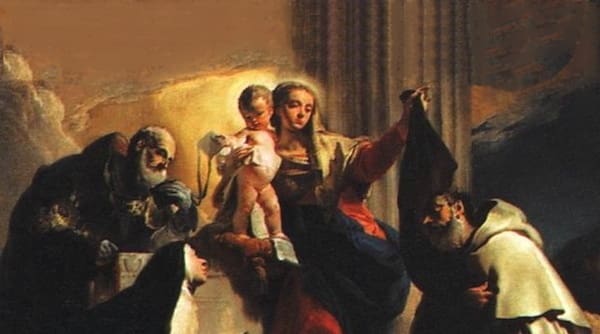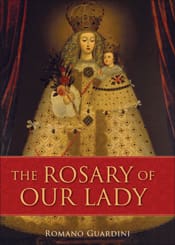THE BEADS AND REPETITION OF THE ROSARY
2 0 0 7
The Beads and Repetition of the Rosary

We should begin with what is most obvious in the Rosary. An aid is used in this prayer: a string or a chain of beads. Some of these beads are larger or are marked apart from the others by a greater distance. Ten smaller beads follow a larger one and form a decade. The whole chain has five such decades. The decades taken together are preceded by a sort of preface, formed by a little crucifix and followed by one large bead and then by three smaller beads.
For the sake of completeness and for those to whom all of this is foreign, we should add that there are some variations of the Rosary that have different divisions, and are only in use in certain places. We should also add that externally the Rosary has taken on manifold and at times beautiful and precious forms, as happens with things that are honored and loved. There can be something very venerable and delicate about an old and nobly designed Rosary that looks as if generations had used it and passed it on.
This string of beads slides through the fingers of the person who prays. At the little cross in the beginning he says the Creed; at every smaller bead, the Hail Mary. At the larger ones that always precede a row of the ordinary beads, he says the Our Father. And after every decade, the doxology: “Glory be to the Father, and to the Son, and to the Holy Spirit; as it was in the beginning, is now, and ever shall be, world without end. Amen.” And all begins and ends with the Sign of the Cross.
What does all this mean? Is not this praying cord a symptom of inferior piety, as the critics say? Is it not something material which contradicts Jesus’ word of exhortation: “God is spirit, and they who worship Him must worship in spirit and in truth”?
Praying means conversation with God. This conversation is life. But all the expressions of life cannot be reduced to the same pattern. There is no prescription for prayer to be taken “as directed.” Revelation tells us who God is and who we are, and in what disposition we should approach Him, but not the precise manner in which to walk and dwell before God. Even words that deal with spirit and truth do not give us that prescription, let alone the fact that they are often misunderstood; for spirit and truth do not contradict outward form and order. Spirit does not mean “thought,” but the Holy Spirit who hovered about Christ, assuming at Pentecost the guidance of Christian history; and truth is not an incorporeal emotion, but rather the living order in which Christ has placed us before the Father. Even in the seemingly most exterior form of prayer, this order can be maintained, this spirit can hold the reins – just as they may become lost in any form of prayer, even the most spiritual and the most interior.
There is a form of prayer in which man expresses a petition or sentiment to God: an appeal, gratitude, or repentance. This he must do sincerely and concisely, and his expression should be in keeping with his innermost impulse. We are reminded here of Christ’s warning against excessive speech. If a person thinks that his request will be more certainly heard if he repeats it ten times, says the Lord, he acts “like the Gentiles.” But if in his anxiety he longs for expression, he may well repeat it ten or a hundred times. Prayer is good when it springs from the heart’s impulse; only otherwise is prayer harmful. We mean here all and everything that basically meets God in a false manner. For the “prattle of the Gentiles” is not evil because of the fifth or tenth repetition, but is evil from the beginning, because it is not an appeal to the Lord of creation but to “a god” whom, regardless of his greatness, one harasses like a man to do one’s bidding.
But there is another kind of prayer in which it is not a matter of simply saying what is in one’s heart, but in which one yearns to dwell in God’s presence. This prayer is inclined to use fewer and fewer words, not because it exhausts itself in the saying, but because it is beyond words. Perhaps what it voices is always the same, over and over again. Just think of St. Francis, who spent whole nights crying out, “My God and my all!” At the end even such words will be dropped, and the soul — so claim the spiritual masters — will enter “nothingness.” Words in this prayer have only the task of supporting the inner emotion, fading away when they have done this service.
Finally, there is still a third form of prayer. It is also centered around a sojourn with God, around a service to Him — in inner self-knowledge and tranquillity, but in a manner that makes a flowing channel out of the words in which it is expressed, a force that keeps the prayer moving. In this type of prayer, new words will not always emerge, but the same words will return. Repetition becomes the outer form of prayer for the purpose of pacifying and fulfilling the inner emotion. The Litany is an example of this type of prayer, with its many related invocations and petitions in which the thought is transformed but slowly. It is very old; we find it at the dawn of Christendom. A similar kind of prayer is the use of Psalms, when the antiphon is inserted between the verses — a constantly recurring invocation. The antiphon, too, is as old as the hills. In this form of prayer we also include the Rosary.
One might object that this repetition leads to an exteriorization of prayer. That may happen, of course; but then one has made a mistake and we are using the Rosary in the wrong way. But exteriorization of prayer does not necessarily happen, for repetition can have a real meaning. Is it not an element of all life? What else is the beating of the heart but a repetition? Always the same contraction and expansion — and yet it makes the blood circulate through the body. What else is breathing but a repetition? Always the same in and out — but by breathing we live. And is not our whole being ordered and sustained by change and repetition? Ever anew the sun rises and sets, night follows day; the round of life begins in the spring, rises, reaches its summit, and sinks. What objection can one raise against these repetitions and so many others? They are the order in which growth progresses, the inner kernel develops, and the form is revealed. All life realizes itself in the rhythm of external conditions and internal accomplishment. If this is so everywhere, why should it not also be so in religious devotion?
The Rosary represents a certain form of religious devotion. The individual may claim that he cannot do anything with it; that is his affair. But he must not call this prayer senseless or un-Christian, for then he would show ignorance.
The string of beads obviously has the purpose of diverting the thoughts from certain external distractions of attention. One bead leads the person praying to the next. Their number keeps the repetition within certain bounds, approved by long usage. Otherwise he who prays would have to keep a watch for the “too little” or else fall into the “too much,” and thus be diverted from the essential. The beads take this trouble off his shoulders; they do the counting for him. Yet is this not something “technical”? Surely; but does not all life contain “technicalities”?
It is said of all things, even the spiritual, that they have to be learned. But learning requires practice; and practice is nothing else but a training of technical skill, liberating our strength and attention for what is essential. So long as one is yet unskilled, one has to watch every single act, and the essential comes off badly; but with the acquisition and development of technical skill, the essential is liberated. The string of beads has no other meaning.
+
 This article is adapted from a chapter in The Rosary of Our Ladyby St. Peter Julian Eymard which is available from Sophia Institute Press.
This article is adapted from a chapter in The Rosary of Our Ladyby St. Peter Julian Eymard which is available from Sophia Institute Press.
Art for this post on the beads and repetition of the Rosary: Cover of The Rosary of Our Lady used with permission; Detail of The Madonna of Carmel and the Souls of Purgatory [Queen of Carmel], Giovanni Battista Tiepolo, 1730s, PD-US author's life plus 100 years or less, Wikimedia Commons.
Read more on the Rosary from Fr. Guardini HERE.
